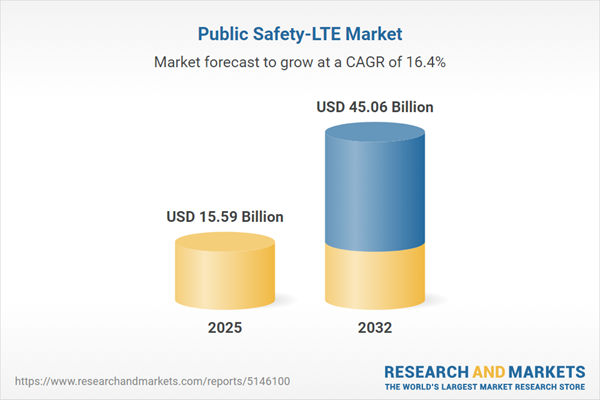Speak directly to the analyst to clarify any post sales queries you may have.
The Public Safety LTE market is undergoing significant transformation, redefining how emergency response agencies communicate and coordinate during critical events. Senior decision-makers in government and industry are actively seeking high-performance, secure LTE solutions to enhance mission-critical operations and inter-agency collaboration.
Market Snapshot: Public Safety LTE Market Growth and Momentum
The Public Safety LTE Market grew from USD 13.35 billion in 2024 to USD 15.59 billion in 2025. It is projected to expand at a CAGR of 16.42%, reaching USD 45.06 billion by 2032. This robust trajectory is shaped by increasing needs for resilient communications, regulatory shifts, and technology adoption across global agencies, utilities, and transport operators. The market's momentum reflects the ongoing transition from legacy voice systems to integrated LTE platforms supporting broadband, video, IoT, and next-generation applications.
Scope & Segmentation
This comprehensive report analyzes critical drivers, segmentation, and technology shifts across the public safety LTE landscape. Market coverage extends by application, offering, deployment models, end-users, frequency bands, and global regions.
- Offering: Equipment (backhaul, core network, network infrastructure and user devices such as drones, handsets, tablets, vehicle-mounted terminals); Services (maintenance, technical support, upgrades, warranty, managed services, network monitoring, remote management, deployment, installation, integration, planning, and design)
- Application: Data services (broadband, mission-critical data), IoT telemetry (asset tracking, SCADA, sensors), location tracking (personnel, vehicles), push-to-talk, video streaming (aerial video, HD surveillance)
- End User: Defense, emergency medical, fire, police, transportation (aviation, maritime, rail), utilities (electric, gas, water)
- Deployment: Dedicated networks, in-building (DAS, repeaters, small cells), mobile ad hoc (mesh networks, vehicle-mounted), outdoor macro
- Frequency Band: High band, low band (700, 800 MHz), mid band (1.4, 2.1, 3.5 GHz)
- Regional Coverage: Americas (North America: U.S., Canada, Mexico; Latin America: Brazil, Argentina, Chile, Colombia, Peru), Europe, Middle East & Africa (Europe: U.K., Germany, France, Russia, Italy, Spain, Netherlands, Sweden, Poland, Switzerland; Middle East: UAE, Saudi Arabia, Qatar, Turkey, Israel; Africa: South Africa, Nigeria, Egypt, Kenya), Asia-Pacific (China, India, Japan, Australia, South Korea, Indonesia, Thailand, Malaysia, Singapore, Taiwan)
- Company Coverage: Telefonaktiebolaget LM Ericsson (publ), Huawei Technologies Co., Ltd., Nokia Oyj, Samsung Electronics Co., Ltd., ZTE Corporation, Motorola Solutions, Inc., Cisco Systems, Inc., Sierra Wireless, Inc., NEC Corporation, Fujitsu Limited
Key Takeaways
- Public safety agencies require scalable LTE networks capable of supporting both traditional voice dispatch and increasingly vital broadband applications like video streaming and telemetry.
- Technology convergence—including IoT, drone surveillance, and mission-critical push-to-talk—is fundamentally reshaping operational response and inter-agency workflows.
- Interoperability and unified command structures are becoming central, enabled by shared standards and seamless data exchange between first responder groups.
- Regional drivers vary, with the Americas leading in network modernizations, EMEA focusing on harmonized policies and pilot deployments, and Asia-Pacific advancing both dense urban and rural LTE rollouts.
- Strategic partnerships and ongoing R&D investment are critical for providers to address evolving security, redundancy, and application integration needs.
Tariff Impact: Navigating Procurement and Sourcing Challenges
Recent trade tariffs introduced in the United States have increased public safety LTE procurement complexity, particularly for network infrastructure and user devices. Agencies and service providers are re-evaluating supplier portfolios and emphasizing modular equipment alignment to control costs. Partnerships for local or regional manufacturing and multi-agency procurement consortia are being utilized to mitigate tariff effects, foster supply chain diversification, and align with budget constraints.
Methodology & Data Sources
The research methodology integrates structured interviews with technical leaders, public safety officials, and manufacturers to capture real-world deployment insights. Comprehensive secondary research draws from industry reports, regulatory filings, academic journals, and patent databases. All analyses have been validated by a multidisciplinary panel of wireless communication specialists and government procurement experts.
Why This Report Matters
- Gain strategic insight into technology adoption and regulatory trends in the fast-evolving public safety LTE environment.
- Identify segmented opportunities, procurement pathways, and partnership models tailored to operational and regional requirements.
- Support investment decisions with validated market data and actionable recommendations focused on resiliency, interoperability, and innovation.
Conclusion
This report equips senior leadership with comprehensive analysis and actionable intelligence to drive effective public safety LTE strategies. The findings facilitate informed decisions on technology selection, procurement, and cross-agency coordination to enhance emergency communications readiness.
Additional Product Information:
- Purchase of this report includes 1 year online access with quarterly updates.
- This report can be updated on request. Please contact our Customer Experience team using the Ask a Question widget on our website.
Table of Contents
3. Executive Summary
4. Market Overview
7. Cumulative Impact of Artificial Intelligence 2025
Companies Mentioned
The companies profiled in this Public Safety-LTE market report include:- Telefonaktiebolaget LM Ericsson (publ)
- Huawei Technologies Co., Ltd.
- Nokia Oyj
- Samsung Electronics Co., Ltd.
- ZTE Corporation
- Motorola Solutions, Inc.
- Cisco Systems, Inc.
- Sierra Wireless, Inc.
- NEC Corporation
- Fujitsu Limited
Table Information
| Report Attribute | Details |
|---|---|
| No. of Pages | 181 |
| Published | October 2025 |
| Forecast Period | 2025 - 2032 |
| Estimated Market Value ( USD | $ 15.59 Billion |
| Forecasted Market Value ( USD | $ 45.06 Billion |
| Compound Annual Growth Rate | 16.4% |
| Regions Covered | Global |
| No. of Companies Mentioned | 11 |









